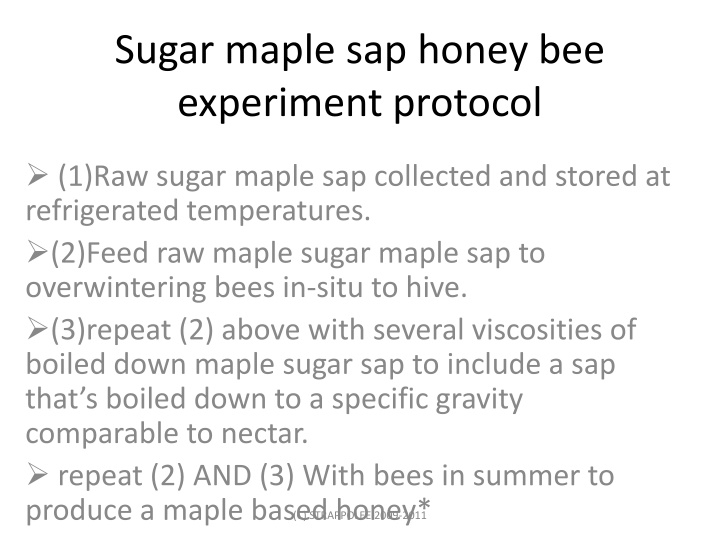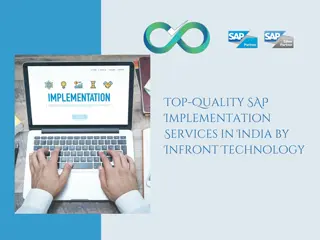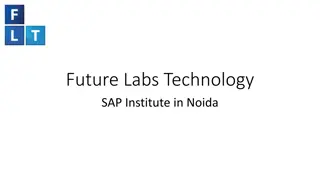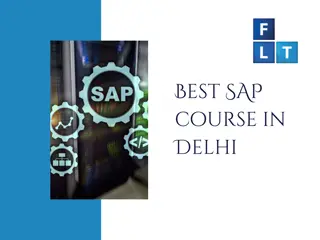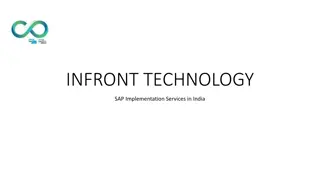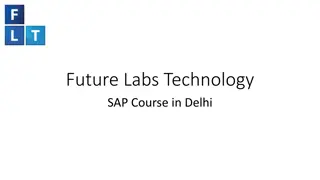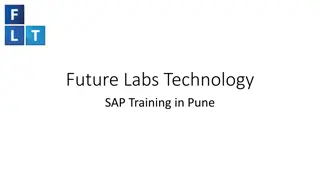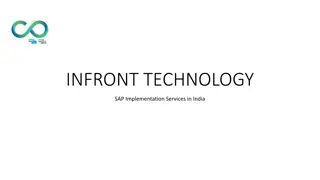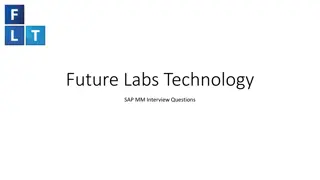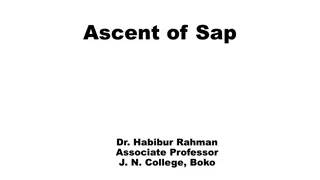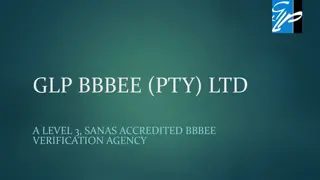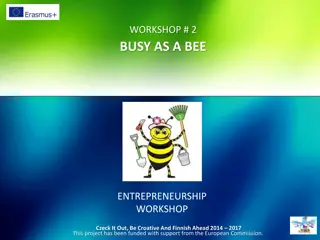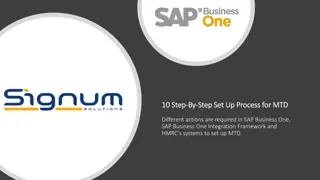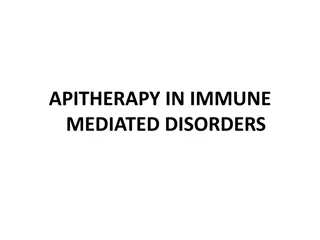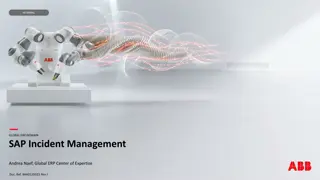Maple Sap Bee Experiment Protocol
This experiment explores the potential of honey bees to metabolize sugar maple sap and produce honey. By feeding bees raw and processed maple sap, researchers aim to investigate the effects on honey production. The hypothesis suggests that boiling maple sap may generate novel compounds that bees can convert into honey. Various viscosities of boiled sap are tested to determine their impact on honey production, raising questions about the optimal boiling point for maple syrup production. The protocol involves collecting and storing raw sap, feeding it to overwintering and summer bees, and analyzing the resulting honey for chemical composition.
Download Presentation

Please find below an Image/Link to download the presentation.
The content on the website is provided AS IS for your information and personal use only. It may not be sold, licensed, or shared on other websites without obtaining consent from the author.If you encounter any issues during the download, it is possible that the publisher has removed the file from their server.
You are allowed to download the files provided on this website for personal or commercial use, subject to the condition that they are used lawfully. All files are the property of their respective owners.
The content on the website is provided AS IS for your information and personal use only. It may not be sold, licensed, or shared on other websites without obtaining consent from the author.
E N D
Presentation Transcript
Sugar maple sap honey bee experiment protocol (1)Raw sugar maple sap collected and stored at refrigerated temperatures. (2)Feed raw maple sugar maple sap to overwintering bees in-situ to hive. (3)repeat (2) above with several viscosities of boiled down maple sugar sap to include a sap that s boiled down to a specific gravity comparable to nectar. repeat (2) AND (3) With bees in summer to produce a maple based honey* (C) STRAPPOLEE 2009-2011
Honey Bee Sugar maple sap hypothesis Boiling of sugar maple sap produces many novel phenols and other compounds, some not found in the sap. Honey bees may very well metabolize sugar maple sap in winter and perhaps in the summer months as well and not produce honey from the raw sap. We hypothesize that honey bees may produce honey from sap that has higher viscosities or specific gravities from the boiling process, this leads to an interesting question, at what point does the boiling process produce the maple syrup phenols? And what novel chemicals would the honey bees produce from partially processed sap? (C) STRAPPOLEE 2009-2011
http://www.sciencedirect.com/science/article/pii/ S1756464611000090 http://pubs.acs.org/doi/abs/10.1021/jf1033398 http://www.mdpi.com/1420-3049/15/7/4572/pdf http://forums.gardenweb.com/forums/load/bees/ msg1113182225132.html http://www.wipo.int/patentscope/search/en/WO2 010134597 http://www.soilandhealth.org/03sov/0302hsted/0 30208miller/030408miller.PDF (C) STRAPPOLEE 2009-2011
http://www.ncbi.nlm.nih.gov/pubmed/21675726 http://www.ncbi.nlm.nih.gov/pubmed/21033720 http://www.rolaine.com/cues/SugarMapleTreeDistr ibution.JPG http://www.mi- maplesyrup.com/directory/producers.htm http://maple.dnr.cornell.edu/Ext/tree_impr/TestFor m.pdf http://maple.dnr.cornell.edu/kids/sugar.htm (C) STRAPPOLEE 2009-2011
http://www.uvm.edu/~pmrc/research06.pdf http://maple.dnr.cornell.edu/Ext/history_tree_imp. htm http://maple.dnr.cornell.edu/Ext/quebec/2006Monog raph.pdf http://www.northamericanmaple.org/index.php/en/n amsc-research-fund http://www.northamericanmaple.org/images/stories/ CropReport/2011USMapleCrop.pdf http://www.statcan.gc.ca/pub/23-221-x/23-221- x2010000-eng.pdf (C) STRAPPOLEE 2009-2011
Protocol equipment needs http://www.bonterrabees.com/hivecaseoptions.ht ml http://www.bonterrabees.com/doityourselfplans.ht ml http://www.honeyrunapiaries.com/observationhive .phtml http://www.honeyrunapiaries.com/beekeeping_pla ns.phtml http://www.draperbee.com/catalog/page7.htm#OB SERVATION HIVES (C) STRAPPOLEE 2009-2011
http://www.beesource.com/build-it- yourself/3-frame-observation-hive-2/ http://www.honeytraveler.com/single-flower- honey/honeydew-or-forest-honeys/ (C) STRAPPOLEE 2009-2011
Veteran owned business owns protocol equipment but on long term loan to community college partner Veteran owned small business contracts with college maintenance to build protocol equipment to benefit the college and instill a entrapernural spirit in students and maintenance employees* College deploys observation hives in science museum and college science classrooms to instill an interest in social insects and economics of social insect products. College deploys hives on college rooftops (C) STRAPPOLEE 2009-2011
College agrees to plant and research sugar maples on campus utilizing cuttings from agriculture research stations The college agrees to plant clover and other nitrogen fixing cover crops that produce forage for bees The city of Port Huron agrees to plant clover around sidewalk trees The city of Port Huron agrees to plant sugar maples as opportunity and funding arises, and to utilize the agricultural research programs trees. (C) STRAPPOLEE 2009-2011
The city of Port Huron agrees to conduct with the college and the veteran owned concern a survey of city and privately owned maple trees Research to be done on a tree leasing scheme to the veteran owned concern for sap production (C) STRAPPOLEE 2009-2011
A proposed Aphid domestication experiment protocol Experiment with several natural or artificial substrates that mimic plant exoderm and Xylem and create a flow of sugar maple or other sap fluids. Entice bees to consume and produce honey. Compare the economics of this process to the expense of boiling sap to produce syrup. (C) STRAPPOLEE 2009-2011
College will consider, Student and employee involvement in research programs , to include honors, food based microbiology options, faculty sponsorship of the above ideas The veteran owned concern will consider employment and employee ownership of any ideas that received help in development (C) STRAPPOLEE 2009-2011
